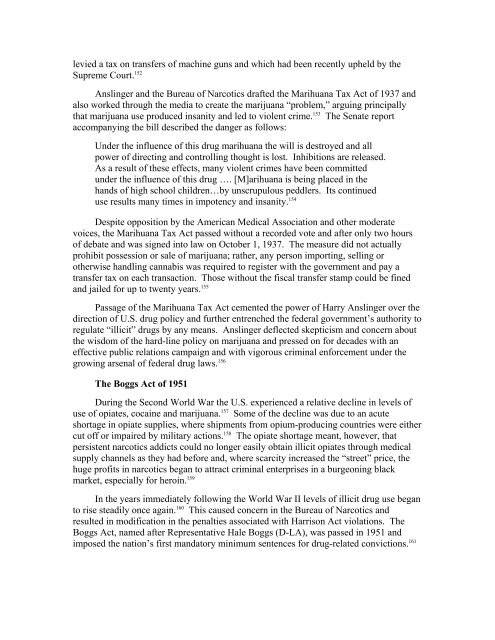Effective Drug Control: Toward A New Legal Framework
Effective Drug Control: Toward A New Legal Framework
Effective Drug Control: Toward A New Legal Framework
Create successful ePaper yourself
Turn your PDF publications into a flip-book with our unique Google optimized e-Paper software.
levied a tax on transfers of machine guns and which had been recently upheld by the<br />
Supreme Court. 152<br />
Anslinger and the Bureau of Narcotics drafted the Marihuana Tax Act of 1937 and<br />
also worked through the media to create the marijuana “problem,” arguing principally<br />
that marijuana use produced insanity and led to violent crime. 153 The Senate report<br />
accompanying the bill described the danger as follows:<br />
Under the influence of this drug marihuana the will is destroyed and all<br />
power of directing and controlling thought is lost. Inhibitions are released.<br />
As a result of these effects, many violent crimes have been committed<br />
under the influence of this drug …. [M]arihuana is being placed in the<br />
hands of high school children…by unscrupulous peddlers. Its continued<br />
use results many times in impotency and insanity. 154<br />
Despite opposition by the American Medical Association and other moderate<br />
voices, the Marihuana Tax Act passed without a recorded vote and after only two hours<br />
of debate and was signed into law on October 1, 1937. The measure did not actually<br />
prohibit possession or sale of marijuana; rather, any person importing, selling or<br />
otherwise handling cannabis was required to register with the government and pay a<br />
transfer tax on each transaction. Those without the fiscal transfer stamp could be fined<br />
and jailed for up to twenty years. 155<br />
Passage of the Marihuana Tax Act cemented the power of Harry Anslinger over the<br />
direction of U.S. drug policy and further entrenched the federal government’s authority to<br />
regulate “illicit” drugs by any means. Anslinger deflected skepticism and concern about<br />
the wisdom of the hard-line policy on marijuana and pressed on for decades with an<br />
effective public relations campaign and with vigorous criminal enforcement under the<br />
growing arsenal of federal drug laws. 156<br />
The Boggs Act of 1951<br />
During the Second World War the U.S. experienced a relative decline in levels of<br />
use of opiates, cocaine and marijuana. 157 Some of the decline was due to an acute<br />
shortage in opiate supplies, where shipments from opium-producing countries were either<br />
cut off or impaired by military actions. 158 The opiate shortage meant, however, that<br />
persistent narcotics addicts could no longer easily obtain illicit opiates through medical<br />
supply channels as they had before and, where scarcity increased the “street” price, the<br />
huge profits in narcotics began to attract criminal enterprises in a burgeoning black<br />
market, especially for heroin. 159<br />
In the years immediately following the World War II levels of illicit drug use began<br />
to rise steadily once again. 160 This caused concern in the Bureau of Narcotics and<br />
resulted in modification in the penalties associated with Harrison Act violations. The<br />
Boggs Act, named after Representative Hale Boggs (D-LA), was passed in 1951 and<br />
imposed the nation’s first mandatory minimum sentences for drug-related convictions. 161
















